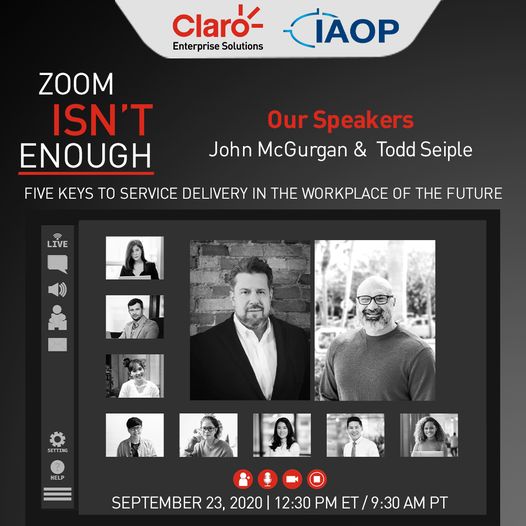
SERVICE DELIVERY EVOLVES TO A 'NEW NORMAL'
Claro Webinar Explores Implications of Move to Remote Workplaces
By: Sandy Frinton, PULSE Editor
|
Looking back over the past eight months, companies have come a long way in shifting to remote workforces. What does the future hold for service delivery models?
IAOP tapped the brainpower of Claro Enterprise Solutions to share its expertise with members during its September Webinar on Zoom Isn’t Enough, Five Keys to Service Delivery in the Workplace of the Future.
John McGurgan, Vice President of Global Managed Services at Claro Enterprise Solutions, shared lessons learned and key trends to watch for moving ahead. To view the Webinar, click here.
What’s Happened?
When the pandemic struck, businesses scrambled to shift employees from traditional office settings to remote workplace models. When the dust settled, businesses found numerous gaps in existing service delivery capabilities. The result: sub-optimal work environments characterized by inefficiencies, sapped productivity and risk.
|
 |
Today, as we evolve towards an uncertain ‘New Normal,’ businesses must improve the quality and security of the remote work experience. But equipping people to work from home isn’t enough. For the long term, service delivery models must be agile, flexible and responsive, and capable of addressing uncertainty and rapidly changing business requirements.
The pandemic exposed weaknesses of service delivery and has demonstrated that remote work is here to stay. The future will be organizational structures that enable remotes workforces to do “work any place, any time, anywhere, using any device,” McGurgan said.
At the start of the pandemic, there was a lot of uncertainty and reactive responses by organizations to quickly equip workers with laptops and devices to work remotely and ensure they had the right connectivity, collaboration, security and support in place to do their jobs.
During these early days of working from home, help desks experienced massive spikes in demand, as remote users struggled to connect new devices and deploy applications from their makeshift offices while the teams themselves lacked the resources and tools to do their jobs remotely.
The Evolution
This initial rush to properly equip workers to work from home has stabilized and organizations are evolving to a ‘new normal.’ Companies are now assessing their existing service delivery models, gaps and maturity levels, as well as rethinking what services they should retain and outsource, the company noted in the Webinar presentation.
“Clients that we have talked to are looking to advance their technology design for a completely remote workforce and they are increasing their technology budgets to drive where they want to be in 2021-22,” McGurgan said.
Predictions for the Future
Claro Enterprise Solutions’ McGurgan made these key points:
- Everything will be in the cloud – Design, delivery and structure will all be cloud-based. Companies will evolve towards full cloud-based managed outsourcing solutions, while collaboration tools like Microsoft Teams, Office 365 and Zoom will continue to expand in usage.
- Service desks will evolve – Call centers will mature from providing basic support backing up internal teams to providing robust, spontaneous Level 1 to 4 support. At the most advanced stages, companies will rely on service providers to deliver full remote monitoring of servers and cloud applications and to react to and solve complex problems remotely. “The service desk support will be the tip of the spear moving forward,” he said.
- Agents will become more sophisticated in their skills – Intelligent automation will be used more frequently to transform call centers, particularly for basic requests such as password resets. Service desk personnel, meanwhile, will upskill to handle more high-end support and deliver greater value.
- BYO devices will increase – Workers will increasingly use their own computers and phones to do their remote work. The trend towards devices and tools that segregate between work and personal functions and usage will continue. Companies in different industries will increasingly look to equip each employee’s device based on personas that define the functionality needed to do a particular job.
- Homeworkers will be more attuned to security threats – Companies will better educate and train remote workers to identify the latest cyber risks so they don’t click on dangerous emails or texts.
- Remote work structures will allow companies to hire talent from anywhere in the world – This will lead to a decrease in regional work centers that recruit employees from only their geographic area and allow companies to hire for specialized skills from any location.
- Savings from establishing remote workforces will be re-invested into technology – Companies will take savings from reduced brick and mortar to invest in technology that supports their vision and strategy of having a true remote mobile workforce going forward.
About the Expert: John McGurgan oversees the development and implementation of relevant offerings, including policies and procedures, recruitment, hiring and compensation, skills development and creating a culture that encourages performance excellence and positive client relationships. A versatile, results-oriented and innovative leader, he has a proven track record of pioneering change in challenging business environments. McGurgan holds degrees in Engineering and Information Technology from Pittsburgh Technical College and has completed Business Management courses at the University of Maryland.
About the company: Claro Enterprise Solutions is a global technology services company that provides proven, tailored solutions and a seamless customer experience to help businesses evolve and adapt to constant change. To subscribe to the blog and for more insights, visit https://www.usclaro.com/insights.